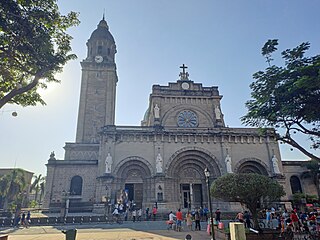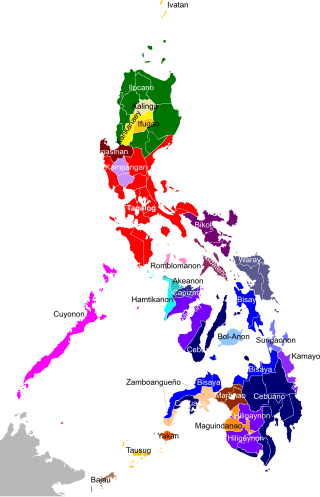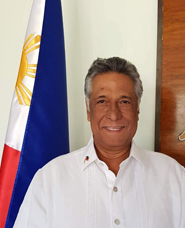Related Research Articles

Luzon is the largest and most populous island in the Philippines. Located in the northern portion of the Philippines archipelago, it is the economic and political center of the nation, being home to the country's capital city, Manila, as well as Quezon City, the country's most populous city. With a population of 64 million as of 2021, it contains 52.5% of the country's total population and is the 4th most populous island in the world. It is the 15th largest island in the world by land area.

Pasay, officially the City of Pasay, is a 1st class highly urbanized city in the National Capital Region of the Philippines. According to the 2020 census, it has a population of 440,656 people.

Christianity is the predominant religion in the Philippines, with Roman Catholicism being its largest denomination. Sizeable minorities adhering to Islam, Indian religions, and indigenous Philippine folk religions are also present.

Filipinos are citizens or people identified with the country of the Philippines. The majority of Filipinos today are predominantly Catholic and come from various Austronesian peoples, all typically speaking Filipino, English, or other Philippine languages. Despite formerly being subject to Spanish colonialism, only around 2-4% of Filipinos are fluent in Spanish. Currently, there are more than 185 ethnolinguistic groups in the Philippines each with its own language, identity, culture, tradition, and history.

Recent archaeological and other evidence suggests Hinduism has had some cultural, economic, political and religious influence in the Philippines. Among these is the 9th century Laguna Copperplate Inscription found in 1989, deciphered in 1992 to be Kawi script with Sanskrit words; the golden Agusan statue discovered in another part of Philippines in 1917 has also been linked to Hinduism.

The Philippines is inhabited by more than 182 ethnolinguistic groups, many of which are classified as "Indigenous Peoples" under the country's Indigenous Peoples' Rights Act of 1997. Traditionally-Muslim peoples from the southernmost island group of Mindanao are usually categorized together as Moro peoples, whether they are classified as Indigenous peoples or not. About 142 are classified as non-Muslim Indigenous People groups, and about 19 ethnolinguistic groups are classified as neither indigenous nor moro. Various migrant groups have also had a significant presence throughout the country's history.
Immigration to the Philippines is the process by which people migrate to the Philippines to reside in the country. Many, but not all, become citizens of the Philippines.

Ramon Delaraga Bagatsing Sr. was a Filipino politician. He was the only Filipino of Indian ancestry and person with disability who served as 19th Mayor of the City of Manila from 1971 to 1986. Bagatsing held the unique distinction of being the only person to survive both the Bataan Death March and the Plaza Miranda bombing in 1971. He was the military hero for the Liberation of Manila during the Second World War.

India–Philippines relations, also knows as Indian-Filipino relations or Indo-Filipino relations, are the bilateral relations between the India and the Philippines. Diplomatic relations between India and the Philippines was established in 1949. India maintains an embassy in Manila, whilst the Philippines maintains one in New Delhi. A Treaty of Friendship was signed between the Philippines and India on 11 July 1952.
Michele Theresa Imperial Gumabao is a Filipino volleyball player and beauty pageant titleholder. She is currently signed to the Creamline Cool Smashers of the Premier Volleyball League (PVL), and has previously played for teams in the Philippine Super Liga (PSL). She was named "Best opposite spiker" five times in her professional career and was the Finals MVP in the 2016 Shakey's V-League Reinforced Conference.
The following is a timeline of the history of the city and metropolitan area of Manila, the capital city of the Philippines.

Gazini Christiana Jordi Acopiado Ganados is a Filipino model and beauty pageant titleholder who was crowned Miss Universe Philippines 2019. She represented the Philippines at the Miss Universe 2019 pageant and finished as a Top 20 semifinalist along with the Best National Costume award.

Miss Universe Philippines 2020 was the first edition of the Miss Universe Philippines competition under its new organization. Previously, the Philippine franchise for Miss Universe was under Binibining Pilipinas Charities, Inc. The coronation night was initially scheduled for May 3, 2020. However, due to the COVID-19 pandemic, it moved at least twice; first to June 14, 2020, and later to October 25, 2020, at the Cordillera Convention Hall, Baguio Country Club in Baguio, Benguet, Philippines.

Miss Universe Philippines (MUPH) is a beauty pageant and organization that selects the Philippines' official representative to Miss Universe—one of the Big Four international beauty pageants.

Rabiya Occeña Mateo is a Filipino model, host, actress, entrepreneur and beauty pageant titleholder who was crowned Miss Universe Philippines 2020. She represented the Philippines at the Miss Universe 2020 pageant and finished as a top 21 semifinalist.
Bernadette Belle Wu Ong is a Singaporean actress, emcee, model, and beauty pageant titleholder who was appointed as Miss Universe Singapore 2020. She represented Singapore at Miss Universe 2020.

Ramon Sevilla Bagatsing Jr., also known as Dondon Bagatsing, is a Filipino lawyer, politician, and diplomat who was the Ambassador of the Philippines to India and Nepal from 2019 to 2022. He was previously a member of the House of Representatives of the Philippines from 1987 to 1998 representing the 4th District of Manila.

The Miss Philippines 2023 was the 1st edition of The Miss Philippines pageant, held on October 24, 2023 at the Mall of Asia Arena in Pasay.
References
- 1 2 "Population of Overseas Indians" (PDF). Ministry of External Affairs (India). 31 December 2018. Archived (PDF) from the original on 25 December 2018. Retrieved 18 April 2019.
- 1 2 With a sample population of 105 Filipinos, the company of Applied Biosystems, analysed the Y-DNA of average Filipinos and it is discovered that about 0.95% of the samples have the Y-DNA Haplotype "H1a", which is most common in South Asia and had spread to the Philippines via precolonial Indian missionaries who spread Hinduism and established Indic Rajahnates like Cebu and Butuan.
- ↑ Kesavapany, K.; Mani, A.; Ramasamy, P. (18 December 2017). Rising India and Indian Communities in East Asia. Institute of Southeast Asian Studies. ISBN 9789812307996 – via Google Books.
- 1 2 "Tamil Cultural Association – Tamil Language". tamilculturewaterloo.org. Archived from the original on 13 April 2015. Retrieved 24 July 2015.
- 1 2 "Reference Populations – Geno 2.0 Next Generation". Archived from the original on 7 April 2016.
- 1 2 Current total Philippines population, worldometers, accessed on: 19 June 2020.
- ↑ Pearson, M. N. (1969). "The Spanish 'Impact' on the Philippines, 1565-1770". Journal of the Economic and Social History of the Orient. Brill. 12 (2): 165–186. doi:10.2307/3596057. ISSN 0022-4995. JSTOR 3596057. Archived from the original on 7 May 2021. Retrieved 22 July 2021.
- ↑ The Unlucky Country: The Republic of the Philippines in the 21st Century By Duncan Alexander McKenzie (page xii)
- ↑ Demography Philippine Yearbook 2011 Archived October 24, 2021, at the Wayback Machine Page 3
- ↑ Bao Jiemin (2005). "Chinese in Thailand". In Carol R. Ember; Melvin Ember; Ian A. Skoggard (eds.). Encyclopedia of Diasporas: Immigrant and Refugee Cultures around the World, Volume 1. Springer. pp. 759–785. ISBN 9780306483219.: 751
- ↑ Stephanie Mawson, 'Between Loyalty and Disobedience: The Limits of Spanish Domination in the Seventeenth Century Pacific' (Univ. of Sydney M.Phil. thesis, 2014), appendix 3.
- ↑ Mawson, Stephanie J. (August 2016). "Convicts or Conquistadores? Spanish Soldiers in the Seventeenth Century Pacific". Past & Present. Oxford Academic. 232 (1): 87–125.
- ↑ "Japanese Christian". Philippines: Google map of Paco district of Manila, Philippines. Archived from the original on 7 May 2010.
{{cite journal}}: Cite journal requires|journal=(help) - ↑ "Spanish Settlers in the Philippines (1571–1599) By Antonio Garcia-Abasalo" (PDF). Archived (PDF) from the original on 17 January 2021. Retrieved 23 November 2020.
- ↑ Peasants, Servants, and Sojourners: Itinerant Asians in Colonial New Spain, 1571-1720 By Furlong, Matthew J. Archived April 29, 2022, at the Wayback Machine "Slaves purchased by the indigenous elites, Spanish and Hokkiens of the colony seemed drawn most often from South Asia, particularly Bengal and South India, and less so, from other sources, such as East Africa, Brunei, Makassar, and Java..." Chapter 2 "Rural Ethnic Diversity" Page 164 (Translated from: "Inmaculada Alva Rodríguez, Vida municipal en Manila (siglos xvi-xvii) (Córdoba: Universidad de Córdoba, 1997), 31, 35-36."
- 1 2 Larena, Maximilian; Sanchez-Quinto, Federico; Sjödin, Per; McKenna, James; Ebeo, Carlo; Reyes, Rebecca; Casel, Ophelia; Huang, Jin-Yuan; Hagada, Kim Pullupul; Guilay, Dennis; Reyes, Jennelyn (30 March 2021). "Multiple migrations to the Philippines during the last 50,000 years". Proceedings of the National Academy of Sciences. 118 (13): e2026132118. doi: 10.1073/pnas.2026132118 . PMC 8020671 . PMID 33753512.
- ↑ "Pre Colonial Period", An Online Guide to Philippine History, geocities.comCollegePark/Pool, archived from the original on 27 October 2009, retrieved 17 May 2008
{{citation}}: CS1 maint: unfit URL (link)[ unreliable source? ] - ↑ "2010/07/528/the-cultural-influences-of-india-china-arabia-and-japan". philippinealmanac.com. Archived from the original on 1 July 2012. Retrieved 24 July 2015.
- ↑ Rajesh Rai, Peter Reeves, ed. (2008). The South Asian Diaspora: Transnational Networks and Changing Identities. Routledge. p. 1. ISBN 9781134105953 . Retrieved 4 October 2013.
- ↑ Peasants, Servants, and Sojourners: Itinerant Asians in Colonial New Spain, 1571-1720 By Furlong, Matthew J. "Slaves purchased by the indigenous elites, Spanish and Hokkiens of the colony seemed drawn most often from South Asia, particularly Bengal and South India, and less so, from other sources, such as East Africa, Brunei, Makassar, and Java..." Chapter 2 "Rural Ethnic Diversity" Page 164 (Translated from: "Inmaculada Alva Rodríguez, Vida municipal en Manila (siglos xvi-xvii) (Córdoba: Universidad de Córdoba, 1997), 31, 35-36."
- ↑ Rye 2006 , p. 713
- ↑ Rye 2006 , pp. 720–721
- ↑ K.Kesavapany, A.Mani and P.Ramaswamy (2008). Rising India and Indian communities in East Asia. LSEAS Publishing. ISBN 978-981-230-799-6.
- ↑ "Indians in the Philippines". Philippines Indian Business and Community guide. phindia.info. Archived from the original on 19 January 2014. Retrieved 21 January 2014.
- ↑ "Departments and offices". Organisation. Asian Development Bank (ADB). Retrieved 21 January 2014.
- ↑ "Community work". phindia.info. Retrieved 21 January 2014.
- ↑ "International Sai Haiyan mission". Sathya Sai Organization. Retrieved 21 January 2014.
- ↑ Sandhu, K.S.; Mani, A. (1993). Indian Communities in Southeast Asia (First Reprint 2006). Institute of Southeast Asian Studies. p. 707. ISBN 9789812304186 . Retrieved 24 July 2015.
- ↑ Enriquez, march (15 October 2011). "Meet some of PH's Fil-Indian businessmen". Inquirer. Retrieved 18 March 2014.
- ↑ Delfin, Fredercik (12 June 2013). "Complete mtDNA genomes of Filipino ethnolinguistic groups: a melting pot of recent and ancient lineages in the Asia-Pacific regio". European Journal of Human Genetics. 22 (2): 228–237. doi:10.1038/ejhg.2013.122. PMC 3895641 . PMID 23756438.
Indian influence and possibly haplogroups M52'58 and M52a were brought to the Philippines as early as the fifth century AD. However, Indian influence through these trade empires were indirect and mainly commercial; moreover, other Southeast Asian groups served as filters that diluted and/or enriched any Indian influence that reached the Philippines
- ↑ "Punjabi community involved in money lending in Philippines braces for 'crackdown' by new President". The Indian Express. 18 May 2016.
- ↑ "We stan this Queen; on 1st paragraph "Rabiya Occeña Sundall Mateo, Miss Universe Philippines 2020, will have a very memorable reign."". Manila Bulletin . Retrieved 30 October 2020.
- ↑ "Rabiya Sundall Mateo usou um look vermelho sensacional". missnews.com.br. Retrieved 20 October 2020.
- ↑ "Meanwhile, Rabiya Sundall Mateo from Ilo-ilo City is the crowned winner of Miss Universe Philippines 2020". zeibiz.com. Retrieved 20 October 2020.
- ↑ "(Her Full name on Major Awards List, Best in Swimsuit: Rabiya Occeña Sundall Mateo, Iloilo City) >> Rabiya Mateo from Iloilo City crowned Miss Universe Philippines 2020". whatalife.ph. Retrieved 20 October 2020.
- ↑ "Mga kaibigan kaklase at kakilala ni Miss Universe Philippines; on 1st paragraph "Rabiya Occeña Sundall Mateo, Miss Universe Philippines 2020..."". Manila Bulletin. 29 October 2020. Retrieved 30 October 2020.
Citations
- Mansingh, Lalit (2000), "20. Southeast Asia" (PDF), Report of the High Level Committee on Indian Diaspora
- Rye, Ajit Singh (2006), "The Indian Community in the Philippines", in A. Mani. (ed.), Indian Communities in Southeast Asia, Institute of Southeast Asian Studies, pp. 707–773, ISBN 981-230-418-5
- Sharma, Jagdish Chandra (1997), Hindu Temples in Vietnam, The Offsetters, ISBN 81-7123-067-9 , retrieved 28 January 2008